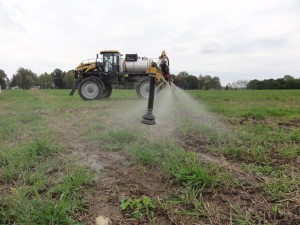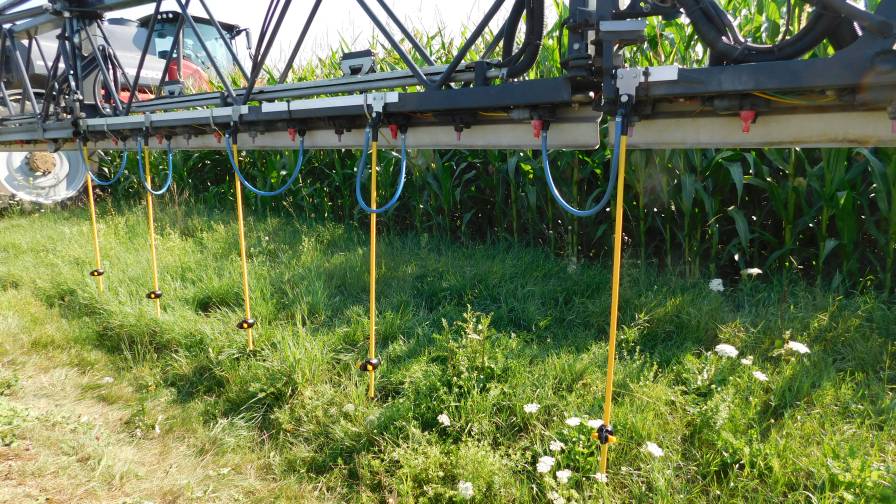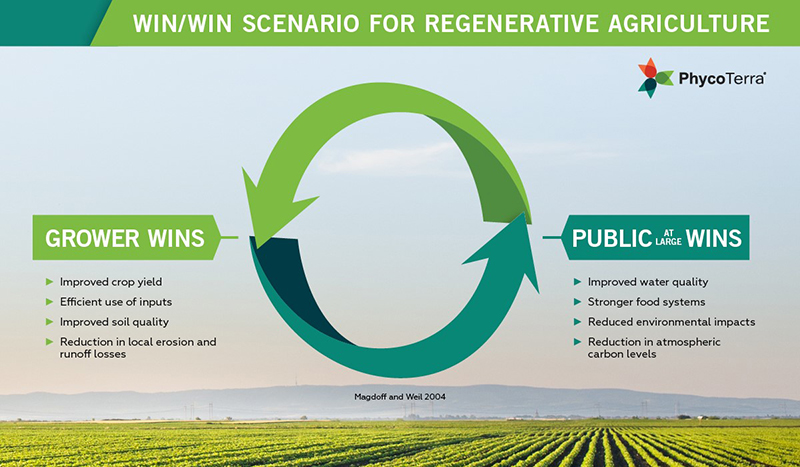Eight Keys To Managing Spray Drift
 If you ask any custom applicator what their top five concerns are when doing their jobs, chances are managing spray drift will be mentioned. The consequences of this are potentially severe, with regulatory fines and/or customer damage claims easily costing several thousands of dollars (if not more).
If you ask any custom applicator what their top five concerns are when doing their jobs, chances are managing spray drift will be mentioned. The consequences of this are potentially severe, with regulatory fines and/or customer damage claims easily costing several thousands of dollars (if not more).
In fact, according to Bruce Senst, director of Agrisolutions adjuvants for WinField Solutions, Shoreview, MN, the potential for spray drift keeps many segments of the agricultural community awake at night. “There are plenty of things that worry your average grower or ag retailer,” says Senst. “But when it comes right down to it, everyone is concerned as all get out about spray drift and its impact on their livelihood.”
Complicating the spray drift issue in recent years is the increasing spread of herbicide-resistant weeds. Based upon the best estimates, approximately 60 million acres of U.S. farmland were infested with herbicide-resistant weeds in 2012, with portions of the Mid-South region particularly hard hit. This has increased the likelihood that applicators will need to use several different crop protection products than they did in previous years.
“Let’s face it — we are coming out of an era where you could use one product technology, glyphosate, to manage most of your application needs,” says Damon Palmer, U.S. commercial leader for the Enlist Weed Control System at Dow AgroSciences, Indianapolis, IN. “But now, to achieve this same level of control, applicators are having to mix other crop protection products into their programs, and that has sparked a lot of questions about how do you manage spray drift when you are using multiple herbicides?”
Furthermore, several crop protection manufacturers such as Dow AgroSciences and Monsanto Co., St. Louis, MO, are readying new herbicide-resistant cropping systems for the marketplace in the coming years. This has the potential to see increased application usage for products such as 2,4-D and dicamba, which in turn, will increase the pressure on applicators to more accurately manage spray drift.
Best Equipment Practices
With these factors in mind, CropLife® magazine spoke with Dr. Robert Wolf, Wolf Consulting & Research, LLC, Mahomet, IL. The past few years, Wolf has spent much of his time conducting the On Target Application Academy (with cooperation from TeeJet Technologies and BASF).
“In my training, I have a list of drift management strategies that I work from,” says Wolf. “I probably trained nearly 3,000-plus applicators in 2012.” In essence, he adds, there are eight best management practices applicators should follow to manage spray drift.
No. 1: Nozzle Selection. “This is the strategy that has been used for years to reduce spray drift,” says Wolf. “However, with today’s nozzle options, there are many more choices from multiple nozzle manufacturers that applicators have. The challenge is how best to set the sprayer parameters — basically speed and pressure — so that while minimizing drift crop protection efficacy is not sacrificed. In recent years, that has been an issue.”
Michelle Vigna, assistant launch manager, Roundup Ready Xtend System for Monsanto, agrees that nozzle selection is one of the keys to preventing spray drift. “Here at Monsanto as we introduce the Roundup Ready Xtend system, we are focusing a lot of attention on proper nozzle selection,” says Vigna. “For our users to achieve the best on-target application, we recommend they use air induction nozzles.”
No. 2: Use lower pressures. This is another widely held method for managing spray drift. However, according to Wolf, this practice might require some adjustment to be effective in today’s application world.
“Forever, the advice to applicators for reducing spray drift was to ‘use a lower pressure,’ which result in larger droplets,” he says. “This was the No. 1 educational point for drift minimization.”
Some of these recommendations have changed, however, as nozzle technology has improved. “Now we have nozzles designed to reduce drift while at the same time doing so at higher pressure,” says Wolf. “The higher pressure is needed to help produce a smaller droplet size increasing the coverage potential on the targeted pest — typically a herbicide on a weed. This fact was not really known when the designs were first introduced.”
As Wolf explains, the design of drift reducing nozzles is to create a pressure drop and, in some cases, introduce air via a Venturi into the mix. Both of these will produce larger droplets.
“When using a drift reducing nozzle at a low pressure, i.e., 30 to 40 psi, it is quite possible, because of the design, that the outlet pressure has been reduced in a ratio of 3:1 or 4:1,” says Wolf. “This can result in an exit psi of 10 to 20 psi. That is too low to maintain a quality pattern or to create droplets for adequate coverage. Thus, the recommendation is to use these Venturi designs — commonly referred to air induction — at pressures ranging from 50 to 80 or higher psi. Even at that high pressure, the amount of drift is less than previous designs at lower pressures.”
No. 3: Increasing flow rates. This is been done by applicators to achieve higher application volumes. According to Wolf, this has been a common practice to reduce spray drift for years. “In general, bigger orifices produce larger droplets,” he says.
However, geography can impact how this practice plays out to manage drift for some applicators. “My years in Kansas provide a different perspective on this issue,” says Wolf. “For the most part, applicators in the Plains states tend to use less water in the spray mix. This is probably a result of the environment . . . less water available for most all things in agriculture and wanting to spray more acres on a tank load of mix. The problem is that when using less water, a smaller-sized nozzle is needed, resulting in smaller, more drift-prone spray droplets. Combine that with modern sprayers capable of higher application speeds — translated to higher pressures — and more drift is possible.”
No. 4: Lower the boom height. Again, cautions Wolf, what applicators have traditionally done in this area may not still be the best way to manage spray drift. “Today, some applicators do not understand that the height of the boom above the target is based on nozzle spacing and overlap requirements to achieve a uniform application across the boom,” he says. “The ‘rule of thumb’ for boom height in the industry is 1:1. That would mean a 20-inch nozzle spacing would require a 20-inch boom height above the target, either the soil in a pre-emergence application or the weed or crop canopy in a foliar scenario.”
Instead, Wolf recommends applicators get their boom heights down to 24 inches. “In my opinion, that will go a long way toward reducing drift,” he says. “I have a slogan for this — lowering the boom on spray drift.”
Other Considerations
No. 5: Watch application speeds. “Most all applicators are using electronics to apply crop protection products,” he points out. “The purpose of a rate controller is to make the application volume uniform. What most do not realize is the speed change will also affect the spray pressure. Higher speeds require higher pressure to deliver the correct volume; lower speeds the opposite. Thus, as applicators are making speed changes, they are impacting the droplet size.”
In his training exercises, Wolf cites this example to illustrate this point: An applicator has set the sprayer up to use a #4 nozzle going 12 mph at 40 psi to deliver 10 gallons per acre. A storm is brewing in the West, so the applicator decides to speed up to 15 mph. A 3 mph speed increase will require the pressure to increase to over 60 psi in order to deliver the same volume through the #4 nozzle. As the storm gets closer, they speed up a second time to 18 mph. Now the pressure will need to be 90 psi to deliver the same volume, which obviously increases the potential for spray drift to occur.
“My educational point is to drive at the speed you calibrated for,” he says. “Also, the rule applicators should remember is that to double the flow from a given orifice size, they will need to increase the pressure four-fold. As an example: If the applicator is going 8 mph at 30 psi and changes to 16 mph, this will cause the pressure to increase to 120 psi.”
No. 6: Avoid adverse weather conditions. According to Wolf, these would include high winds, calm air or inversions. “This is an area that applicators have no control over,” he says. “But the best option is still to choose not to spray when environmental conditions are not favorable.”
No. 7: Use buffer zones. As Wolf points out, the increase in different herbicides, coupled with label requirements, in the near future will make these more important for applicators to achieve proper on-target work. However, size could be an issue.
“The size of the buffer zone will be the problem,” he says. “The concern today is that ground applicators might not consider not spraying next to a sensitive area by leaving a buffer zone. Instead, they might choose to come back on a day when the wind is blowing away from the sensitivity to spray.”
No. 8: Consider other technologies to reduce drift potential. According to Wolf, this could include the use of shields, air-assist or pulse-width modulation or drift reduction additives such as adjuvants.
In summation, Wolf reminds applicators that all of these practices are good at reducing the potential for spray drift, but only if they aren’t chosen selectively. “A good drift management plan will include multiple strategies,” he concludes. “One item from this list will not be sufficient alone. One practice alone does not make for a good plan.”






